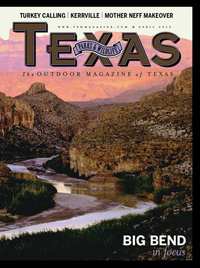
Mother Neff Makeover
The grand dame of state parks looks better than ever.
By Rob McCorkle
Ravaged by the march of time, decades of public use and frequent flooding, old Mother Neff State Park, now almost 80, was in dire need of a major facelift. Park planners, resource specialists and architects stepped up to provide a $6.5 million makeover to ensure that this historic park can continue serving as a recreational oasis for generations to come.
Earlier this year, state and local officials gathered for a grand reopening ceremony at the park’s new headquarters, constructed of cut limestone and designed to complement the architectural style employed in the 1930s by the skilled craftsmen of Company 817 of the Civilian Conservation Corps. Opened to the public in 1937, Mother Neff State Park is one of only a select number of Texas state parks listed on the National Register of Historic Places.

The handsome new headquarters is located at the northern upland reaches of the park, far away from the oft-inundated Leon River bottomlands portion of the park. Visitors now access the park, southwest of Waco, through a new Texas Highway 236 entrance.
Mother Neff State Park, where Central Texans have gathered for decades to enjoy the outdoors, has been subject to repeated flooding that has affected park operations and closed the park to day users and campers for extended periods. One particularly severe event in 1991 flooded the park with 23 feet of water, inundating the park’s bottomland where the historic CCC-built rock tabernacle, group recreation hall and old park headquarters are located and closing the park for six months. Subsequent major flooding occurred in 1993, 1998, 2002, 2005 and 2007.
The new headquarters houses a Texas State Park Store, a multimedia room and a host of new exhibits that highlight the park’s abundant natural resources and provide insight into the park’s history through the use of CCC artifacts, historic photos and interpretive panels. Architects positioned the building to take advantage of the natural terrain and sun angles to maximize energy efficiency, and incorporated a rain collection system into the “green building” design.
The extensive park redevelopment also includes new maintenance facilities and a 20-site, multiuse campground with 50-amp service and restrooms, enhancing the existing camping options. One unusual aspect of the park renovation pertains to the location of the new camping loop. Park planners went to great lengths to find the exact location of the old CCC camp and put the new campground within the camp’s archeological remnants. The result is that today’s visitors can sleep, eat and cook in the location of the old CCC workers camp.

The tree-shaded parkland tamed by the skilled hands of CCC workers remains one of the state’s most alluring natural sanctuaries. For more than a century, Mother Neff has been a popular spot for family reunions, church gatherings, picnics and, more recently, weddings.
Much of the appeal to wedding parties, families and others stems from the park’s rustic rock and wood structures built from 1934 to 1938, including a stone concession building (now utilized as a recreation hall), a large open-sided rock tabernacle and a water/observation tower. A wood-frame tabernacle stands at the site of the original hip-roofed structure built by Gov. Pat Neff in the pecan bottomland on the family’s original six acres. He officially deeded an additional 250 acres to the state for a park on (appropriately) Mother’s Day in 1934. Frank Smith deeded an additional three acres to increase the park’s original size to 259 acres. The state acquired 140 more acres for the park in 2012.
The park’s natural history rivals its cultural past. Three ecological zones overlap within the park. Rich bottomlands abut the limestone escarpment that merges with the upland prairies. Towering pecans, cottonwoods, sycamores and a variety of oaks cloak the river bottoms in a dark green canopy. The limestone hills, which define the edge of the Texas Hill Country, teem with wildlife.
Future phases set forth in the park’s redevelopment plan, to be implemented when funding becomes available, include a group hall, a campfire theater, a small group bunkhouse, cabins, riverside kayak launch and comfort station, and repairs to the historic CCC structures.
Despite all of the changes, the park remains true to Neff’s observation that: “Nothing is more conducive to the happiness of a people than to go where the bees hum, the birds sing, the breezes blow. … These places must be preserved, not only for the present, but for posterity.”
» Like this story? If you enjoy reading articles like this, subscribe to Texas Parks & Wildlife magazine.
Related stories
Park Pick: Hiking the Woods and Prairies
Texas Reader: Who is Mother Neff?

